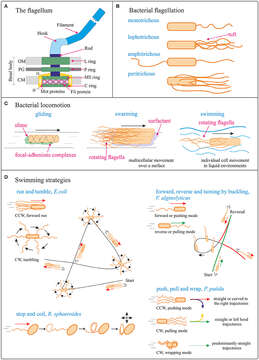Bacterial locomotion

Description:
Description: English: Bacterial locomotion (A) Schematic (not to scale) structure of the flagellum in Gram-negative bacteria. OM, outer membrane; PG, peptidoglycan cell wall; CM, cytoplasmic membrane. Adapted from Madigan et al. (2014). (B) Different types of bacterial flagellation. (C) Different bacterial locomotion strategies: gliding (focal adhesion model) (adapted from Islam and Mignot, 2015), swarming (adapted from Kearns, 2010), and swimming. The direction of bacteria movement is indicated by black arrows. (D) Schematics (not to scale) of different swimming strategies. Run and tumble from Escherichia coli; forward, reverse, and turning by buckling of Vibrio alginolyticus (adapted from Son et al., 2013); stop and coil from Rhodobacter sphaeroides (adapted from Armitage and Macnab, 1987; Armitage et al., 1999); push, pull, and wrap from Pseudomonas putida (adapted from Hintsche et al., 2017). The direction of bacteria movement is indicated by the arrows. References: Madigan, M. T., Bender, K. S., Buckley, D. H., Martinko, J. M., and Stahl, D. A. (2014). Brock Biology of Microorganisms. Amsterdam: Addison-Wesley Longman. Islam, S. T., and Mignot, T. (2015). The mysterious nature of bacterial surface (gliding) motility: a focal adhesion-based mechanism in Myxococcus xanthus. Semin. Cell Dev. Biol. 46, 143–154. doi: 10.1016/j.semcdb.2015.10.033 Kearns, D. B. (2010). A field guide to bacterial swarming motility. Nat. Rev. Microbiol. 8, 634–644. doi: 10.1038/nrmicro2405 Son, K., Guasto, J. S., and Stocker, R. (2013). Bacteria can exploit a flagellar buckling instability to change direction. Nat. Phys. 9, 494–498. doi: 10.1038/nphys2676 Armitage, J. P., and Macnab, R. M. (1987). Unidirectional, intermittent rotation of the flagellum of Rhodobacter sphaeroides. J. Bacteriol. 169, 514–518. doi: 10.1128/jb.169.2.514-518.1987 Armitage, J. P., Pitta, T. P., Vigeant, M. A., Packer, H. L., and Ford, R. M. (1999). Transformations in flagellar structure of Rhodobacter sphaeroides and possible relationship to changes in swimming speed. J. Bacteriol. 181, 4825–4833. Hintsche, M., Waljor, V., Großmann, R., Kühn, M. J., Thormann, K. M., Peruani, F., et al. (2017). A polar bundle of flagella can drive bacterial swimming by pushing, pulling, or coiling around the cell body. Sci. Rep. 7:16771. doi: 10.1038/s41598-017-16428-9. Date: 20 August 2018, 17:43:56. Source: [1] doi:10.3389/frobt.2018.00097. Author: Julio Bastos-Arrieta, Ainhoa Revilla-Guarinos, William E. Uspal and Juliane Simmchen.
Included On The Following Pages:
- Life
- Cellular
- Bacteria
- Proteobacteria (Purple Bacteria & relatives)
- deltaepsilon subdivisions
- Deltaproteobacteria
- Myxococcales (fruiting gliding bacteria)
- Cystobacterineae
- Myxococcaceae
- Myxococcus
- Myxococcus xanthus
This image is not featured in any collections.
Source Information
- license
- cc-by-sa-3.0
- copyright
- Julio Bastos-Arrieta, Ainhoa Revilla-Guarinos, William E. Uspal and Juliane Simmchen
- creator
- Julio Bastos-Arrieta, Ainhoa Revilla-Guarinos, William E. Uspal and Juliane Simmchen
- source
- [1] doi:10.3389/frobt.2018.00097
- original
- original media file
- visit source
- partner site
- Wikimedia Commons
- ID


